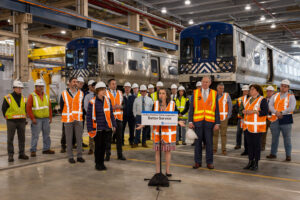
It’s been there more than a century, and now it’s ready for the next century, thanks to the newly completed $1.1 billion construction project that’s been in the works since 2001 – with both state and federal funding making the project possible.
“The Harmon Yard is the heart of Metro-North’s operations… now, with a completed Harmon Yard, the railroad can continue to deliver exceptional service to the tens of thousands daily riders,” says MTA Metro-North Railroad President Catherine Rinaldi.
The MTA says completion of a five-phase, 23-year upgrade to the Harmon Shop will help improve service for riders. “Metro-North service has never been better – 99% on-time performance so far this year. A big reason is the way our car fleet is being maintained and repaired here at the Harmon Shop,” says MTA Chair and CEO Janno Lieber.
When the MTA took control of the site in 1983, it says it was “inadequate” to meet the maintenance needs that are essential for a large railroad. With its improved facility, the MTA says it “will be able to maintain train reliability and meet the maintenance needs of its operations for decades.”
The upgrades include brand-new repair and support shops, new coach and locomotive shops, and power sources that reduce the number of idling trains, thereby reducing noise and emissions. The facility also now has a dozen car-hoists, enabling crews to work on multiple trains at once, for speedier and more efficient maintenance.






